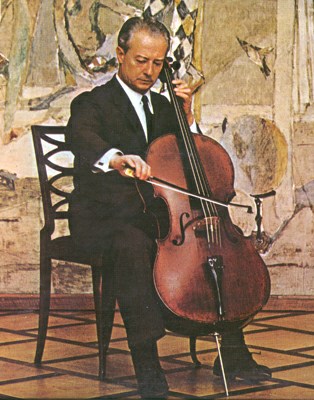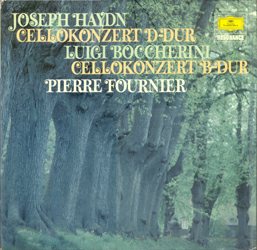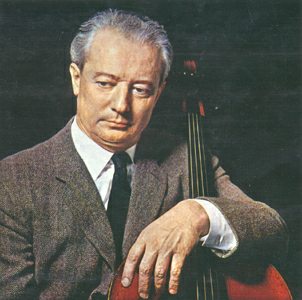* FOURNIER, Pierre(24th Jun. 1906 ~ 8th Jan. 1986)
[ Prince of the cello ]
 Pierre
Fournier is a member of glorious school of French
cellists in 20th century after Casals - from Paul
Bazelaire and Maurice Maréchal, Fournier, Tortelier, Navara,
and Gendron - and perhaps most famous in them. He is
almost incarnation of 'gracefulness' used in depicting
French players, called 'Prince of the cello'. What a good and enviable
nickname!
Pierre
Fournier is a member of glorious school of French
cellists in 20th century after Casals - from Paul
Bazelaire and Maurice Maréchal, Fournier, Tortelier, Navara,
and Gendron - and perhaps most famous in them. He is
almost incarnation of 'gracefulness' used in depicting
French players, called 'Prince of the cello'. What a good and enviable
nickname!
He was
born in Paris as a son of army general, from a musical
family(His brother Jean is also a famous violinist, whose
wife is Jeanette Doyen - Jean Doyen's sister. He made
trio team with Badura-Skoda and Antonio Janigro and recorded many trio repertoires
at Westminster label). He learned piano, but suffered
from polio and changed to cello at nine because he had
problems in pedaling from the aftereffects of it. He was
taught from 1918 by André Hekking, later famous teacher Paul
Bazelaire in Paris Conservatoire. He graduated at the
first prize in 1923, making début
next year in Paris. He became solist of Colonne Orchestra
on Jan. 1927, starting concert tour in Europe. Invited by
Berlin Philharmonic in 1933 he went to Germany, which
established his international fame. Maybe he knew Furtwängler
at this time, and broadcast recording of Dvorák concerto
2nd mvt.(1942; more or less dubious) and Schumann
concerto 3rd mvt. remained.
His activity in chamber music right
after début was very impressive. In 1943, he
succeeded Casals in the legendary trio whose other
members were Alfred Cortot and Jacques Thibaud. His affection to this genre is essential
to his career. From 1941 to 1949 he taught at Paris
Conservatoire, when he recorded mainly for EMI under
Walter Legge's control after WWII. 'Introuvable de
Fournier' by EMI(4 CD set), and Fauré's Piano quartet No.2 recording in
1940(with Marguerite Long and Thibaud) represent this years.
After quitting the teaching job, he
concertrated on all of his time to concert performances.
His début at USA was 1948,
USSR 1961(where he carried a jury of Tchaikovsky Concour
with Rostropovich), Japan, and Korea in 1978. His partner at podium were almost
all of the famous conductors in 20th century, including Furtwängler, Walter, Szell, Kubelik, Karajan, Clemens Krauss,
Cellibidache, Martinon, and Karl Münchinger. Other partners were Backhaus, Kempff, Gulda, Rubinstein, Schnabel, Firkusny, Lipatti, David Oistrakh, Sviatoslav Richter, Francescatti, Szeryng, and Szigeti, etc.
- all-star members. After late 1960s, he liked to play
with his son Jean-Pierre(as Jean Fonda at records). In
1953, French government honored him by Région
d'honeur. His bow was finally stopped on 8th Jan. 1986 by
a stroke, shortly before his second visit plan to Korea.
His artistry was 'deriving most of gracefulness of the work he played'. His tone and musical fluence is never hard, and so fluent that I usually come to forget it is very difficult to play cello like him. But his beautiful tone does never spoil the whole musical span, which shows his supreme experience and musicality. Listening to Casals I realize his humanity and deep concentration on the essence of the works he thought to be, and to Rostropovich I am moved by his overwhelming technique, power, and vast scale. Fournier always has me consider again how beautiful the works are. Obviously, difficult to judge which of the two player is better, I think Fournier is somewhat better than Rostropovich in the recordings from baroque to classical era. The latter often shows some disaccord to his partners, but Fournier never. And his ensemble is almost such an instinct that his best realm seems to be chamber music, I think(Perhaps it is prejudice from my taste. ^^). Of course, it depends on the playing style, but isn't it minus if a cellist has problem at chamber music?
 His recordings are
released much as CD, and lucky in transffering. Mainly
EMI From début to mid 50s,
Decca in 50s. His most important career as recording
artist is a 'title cellist' representing DG from late 50s to late 60s,
after which he recorded freely at RCA, EMI, Erato,
Philips, and Sony. My discography includes almost all of
the so-called standard cello repertoire(though he did not
record as many comtemporaries as Rostropovich). Of course
DG is the central company, but considerable amount in
other companies
His recordings are
released much as CD, and lucky in transffering. Mainly
EMI From début to mid 50s,
Decca in 50s. His most important career as recording
artist is a 'title cellist' representing DG from late 50s to late 60s,
after which he recorded freely at RCA, EMI, Erato,
Philips, and Sony. My discography includes almost all of
the so-called standard cello repertoire(though he did not
record as many comtemporaries as Rostropovich). Of course
DG is the central company, but considerable amount in
other companies
But,
it is natural that his representative recordings be those
of DG in his peak times. In that aspect, I want to
recommend Haydn's D major and Boccherini's B flat
major concertos(DG)
above all. Being really classical and full of dignity, I
have never heard better than this though text is somewhat
romantic in the viewpoint of authenticism. Bach's unaccompanied cello
suites(Archiv) is next. I think
this is the best record by modern cello even though
including Casals' legendary one. His
graceful and balanced playing is perfectly matched to
Bach's music. These two recordings are essential to
Fournier's fans. Accompanied by Szell/BPO, Dvorák's
concerto(DG) is one of the best
recording of this work, especially the best in the aspect
of harmony between solo and orchestra. This record is the
best choice to the newly listener of this work. Other famous concertos are Lalo,
Saint-Saëns No.1(DG), Bruch's 'Kol Nidrei'(DG), and
the reputation of R.Strauss' 'Don Quixote' conducted by
Szell(Sony) and Karajan(DG) have already been firmed.
Beethoven and Brahms' sonatas are
recommendable in his chamber
music recordings. Beethoven's sonatas was recorded three
times, in which I want to name the ones with
Gulda(studio) and Kempff(Paris live), all of DG label. Though Kempff made some
mistakes, I think the later live recording is somewhat
better in the aspect of equivalent fusion of two players,
and cheaper(^^). In Brahms' sonatas, only the record with
 Backhaus(Decca) is
now available, but very great and at the summit. The
nexts are trio recordings with Artur Rubinstein and
Henryk Szerying, including Brahms' Nos.1~3, Schumann's
No.1, and Schubert's Nos. 1 &2(all RCA label). These
are one of the most beautiful trio records after Oistrakh
trio's EMI recording. Beethoven's complete trios with
Kempff and Szerying(DG) are also good, recorded in
1969~70(Beethoven's bicentennial). Other sonatas are
'Arpeggione' with his son(DG), Bach with
Ruzickova(Erato), Poulenc(EMI), and Debussy &
Martinu(Sony). Small pieces(DG) is proud of his very
sophisticated style and was available by double series
and now by Original Masters release.
Backhaus(Decca) is
now available, but very great and at the summit. The
nexts are trio recordings with Artur Rubinstein and
Henryk Szerying, including Brahms' Nos.1~3, Schumann's
No.1, and Schubert's Nos. 1 &2(all RCA label). These
are one of the most beautiful trio records after Oistrakh
trio's EMI recording. Beethoven's complete trios with
Kempff and Szerying(DG) are also good, recorded in
1969~70(Beethoven's bicentennial). Other sonatas are
'Arpeggione' with his son(DG), Bach with
Ruzickova(Erato), Poulenc(EMI), and Debussy &
Martinu(Sony). Small pieces(DG) is proud of his very
sophisticated style and was available by double series
and now by Original Masters release.
Perhaps it's nothing to be desired if a great artist is also good-natured. Fournier seemed to be so. Friedrich Gulda does not resemble Fournier in any way, but Gulda played with him in about 30 concerts and recorded Beethoven's complete sonatas. He said "He was the more seasoned, and my superior. I owe him a great deal. I learnt a huge amount from him, musically, about taking things seriously, and he guided me, kindly but also very strenuously." Of no other musician does Gulda spoke with so much respect, affection and warmth as Fournier. Later, Heinrich Schiff tried to persuade gulda to join him in a new recording of the Beethoven's sonatas, but in vain. Gulda said to him, "Don't build up your hopes. I was so spoilt by Fournier that it's out of the question for me, great as it might be."
The resources
- Fournier ; DG 135 132 & DGG 138 669 SLPM(LPs)
- Cello Concerto by Haydn & Boccherini ; DG 2535 179(LP)
- Anecdote by Gulda ; liner note of DG 437 352-2, by Reinhard Beuth
Links
- Recommended article ; http://www.cello.org/cnc/fournier.htm
- A personal fan page ; http://www.geocities.co.jp/MusicHall-Horn/1489/fournier.html (Japanese)
(c) 2000~, Youngrok LEE ; Link free, but please get my approval before you reuse, copy, or quote this materials
Created ; 29th Aug. 2000
Last update ; 4th Jun. 2007